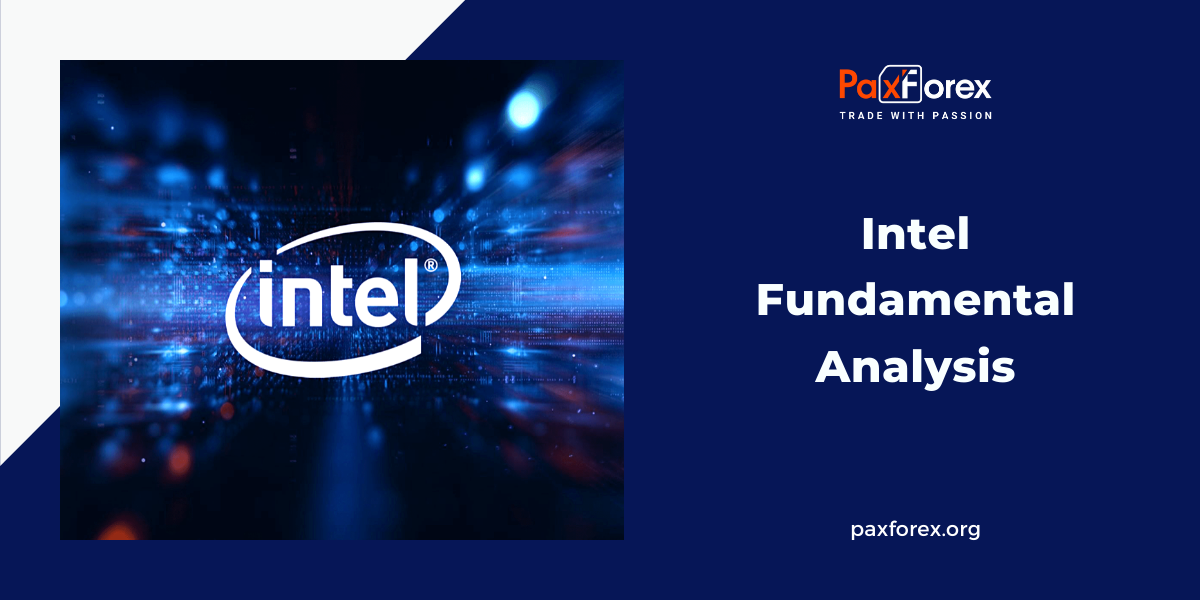
Source: PaxForex Premium Analytics Portal, Fundamental Insight
Intel has faced a challenging period over the past few years, particularly in the aftermath of the pandemic, with the PC market experiencing setbacks. The company witnessed a decline in market share to its competitor, Advanced Micro Devices, in both PC and server CPUs. Despite declining revenue and profits, Intel persisted with its costly initiative to establish its own foundry business, which initially did not inspire confidence in the market.
However, there seems to be a shift in sentiment among investors regarding Intel's potential resurgence. In the current year, Intel's stock has surged by approximately 80%, albeit from a previously low valuation. Looking forward to 2024 and beyond, there is optimism that Intel's stock may continue to be a rewarding investment as various elements of the company's turnaround strategy begin to show positive results.
- A Resurgence in Manufacturing
Until approximately 2017, Intel enjoyed a virtual monopoly in the PC and server CPU markets, facing little competition. Meanwhile, AMD struggled due to poor decisions made in the early 2010s. Intel's challenges in scaling its 10nm manufacturing process to mass production seemed inconsequential at the time. Although initially slated for completion by 2016, the 10nm process encountered numerous delays, pushing its readiness back by several years.
However, these delays proved consequential for Intel as AMD made a significant comeback. Utilizing advanced manufacturing processes from Taiwan Semiconductor, AMD introduced Ryzen PC CPUs and EPYC server CPUs, gradually eroding Intel's market share and eventually surpassing the industry giant in both performance and efficiency.
To compete with TSMC and AMD, Intel recognized the need for substantial manufacturing investments, prompting a fundamental shift in its business model. The company is now actively expanding its own foundry business, aspiring to become a key player in chip manufacturing for external clients.
Intel is leaving no stone unturned, adhering to an ambitious roadmap. The Intel 4 process is currently deployed in the Meteor Lake laptop chips, while Intel 3 is slated for the 2024 server CPU lineup. Plans include using Intel 20A for Arrow Lake PC CPUs later in 2024, and Intel 18A is expected to be operational by the end of the following year.
Intel's upcoming processes, Intel 20A and Intel 18A, promise groundbreaking innovations, featuring a new transistor design and backside power delivery. Intel asserts that the 18A process will outpace TSMC's upcoming N2 process, scheduled for release a year later. If Intel's assertions prove accurate, chip designers seeking cutting-edge manufacturing technology may turn to Intel.
The foundry market, currently valued at over $100 billion, is projected to more than double in size by 2032. While the full impact will unfold over the years, Intel's venture into the foundry business holds the potential to become its most lucrative revenue stream in the future.
- PC Market Rebound
After enduring two consecutive years of decline, global PC shipments are anticipated to rebound in the fourth quarter of this year. Although 2024 may not be a groundbreaking year for the PC industry, Gartner projects a 4.9% growth in shipments, offering a welcome relief to PC and component manufacturers navigating the challenging post-pandemic landscape.
This resurgence aligns seamlessly with the launch of Intel's Meteor Lake laptop CPUs earlier this month. Meteor Lake introduces several innovations, such as a tiled architecture enabling Intel to mix manufacturing processes and integrated AI hardware. Convincing consumers of the need for an "AI PC" may require strategic marketing efforts, as the advantages lie in offloading AI inference tasks to dedicated hardware, resulting in a more responsive experience and improved battery life.
Despite the challenge of promoting these features to consumers, Intel's new chips are set to feature in over 230 systems in the coming year. Intel's plans include the launch of Arrow Lake chips in 2024, expected to find their way into desktop systems. Looking ahead to 2025, the anticipated end-of-life for Windows 10 could trigger a substantial PC upgrade cycle, indicating a potential solid recovery for Intel's PC business in 2024 and 2025.
- Reclaiming the Server CPU Market
While Intel has maintained competitiveness in the PC CPU market, it faces significant challenges against AMD's latest server CPUs. The long-awaited Sapphire Rapids chips, launched in January, struggled to match the raw performance and efficiency of AMD's Genoa chips. Although Intel has made strides with the recent launch of Emerald Rapids, it remains in a catch-up position.
Intel's true comeback is expected next year with the launch of two families of server CPUs built on the Intel 3 process. Granite Rapids, focused on power, aims to boost core count to better compete with AMD. Meanwhile, Sierra Forest will prioritize efficiency, featuring numerous lower-performance cores tailored for cloud workloads.
Intel's manufacturing advancements play a crucial role in this resurgence. The Intel 3 process, utilizing extreme ultraviolet lithography at a 3nm-class node, promises significant performance and efficiency improvements over the aging Intel 7 process used for Sapphire Rapids and Emerald Rapids. By 2025, Clearwater Forest is set to succeed Sierra Forest, transitioning to the Intel 18A process. While details about the successor to Granite Rapids are unknown, it is likely to follow a similar advancement.
If Intel successfully regains its manufacturing edge over TSMC in late 2024, the company stands poised to recapture lost market share from AMD in the server CPU market.
As long as the price is above 41.00, follow the recommendations below:
- Time frame: D1
- Recommendation: long position
- Entry point: 47.88
- Take Profit 1: 50.00
- Take Profit 2: 55.00
Alternative scenario:
If the level of 41.00 is broken-down, follow the recommendations below:
- Time frame: D1
- Recommendation: short position
- Entry point: 41.00
- Take Profit 1: 38.00
- Take Profit 2: 35.00













